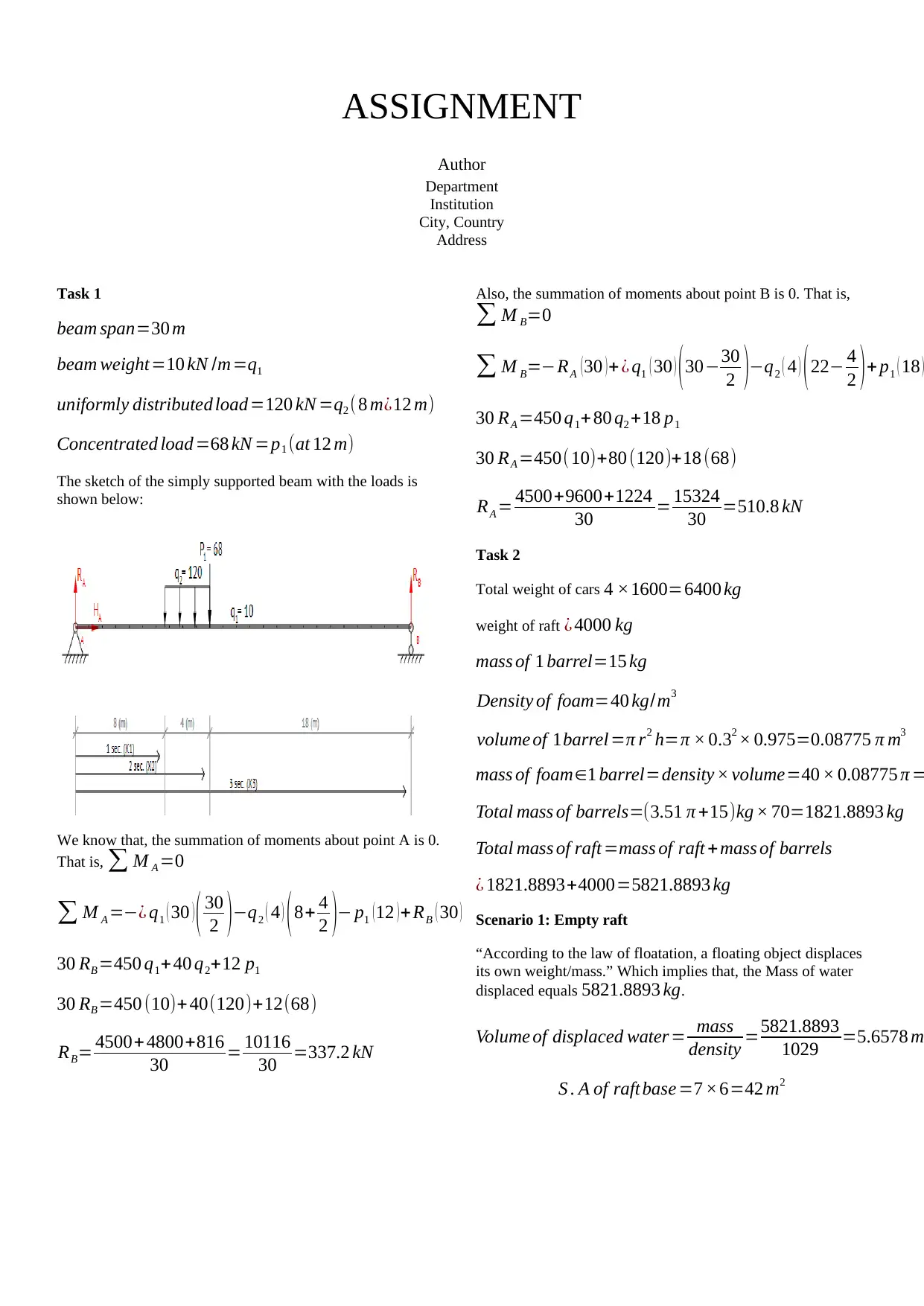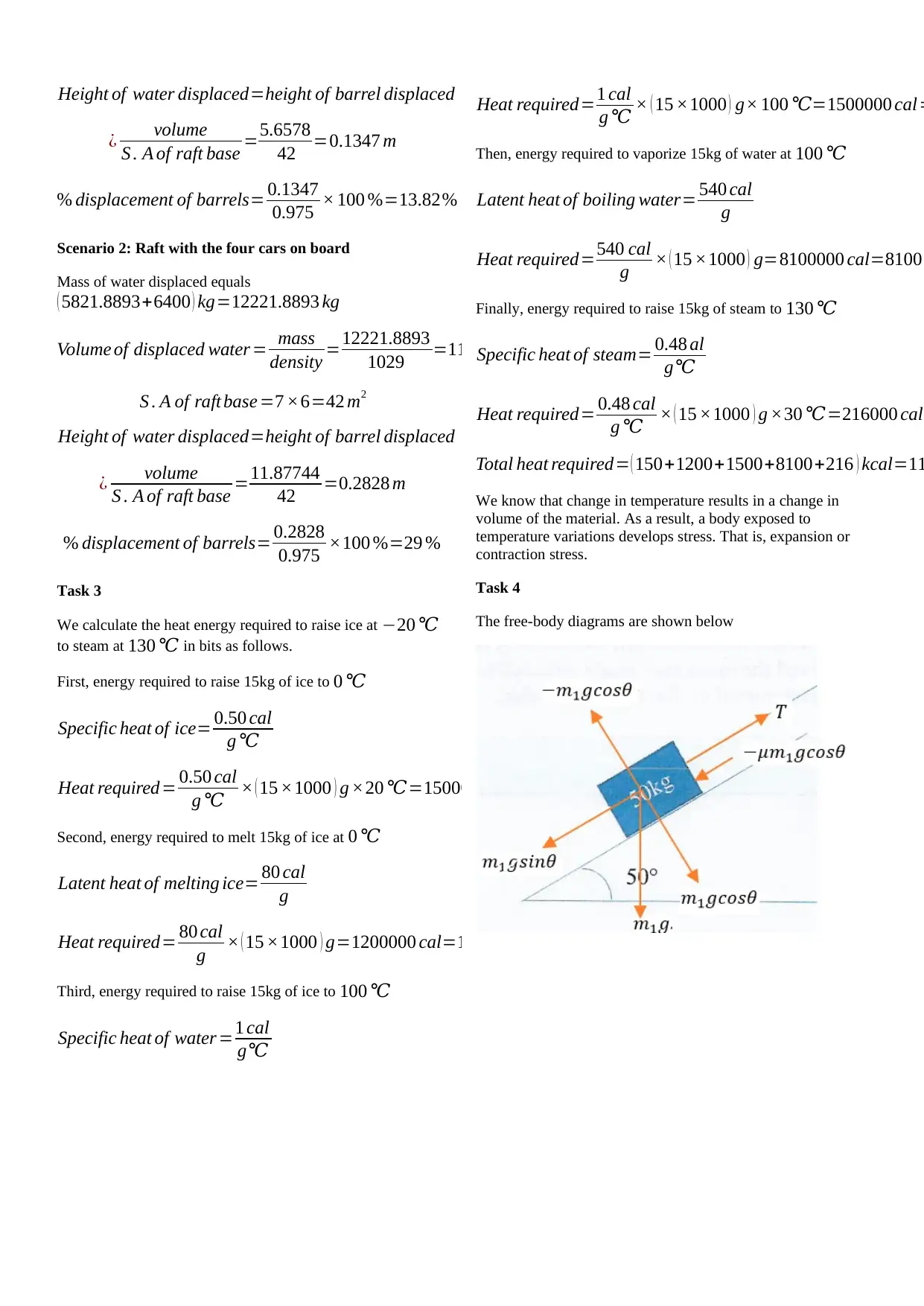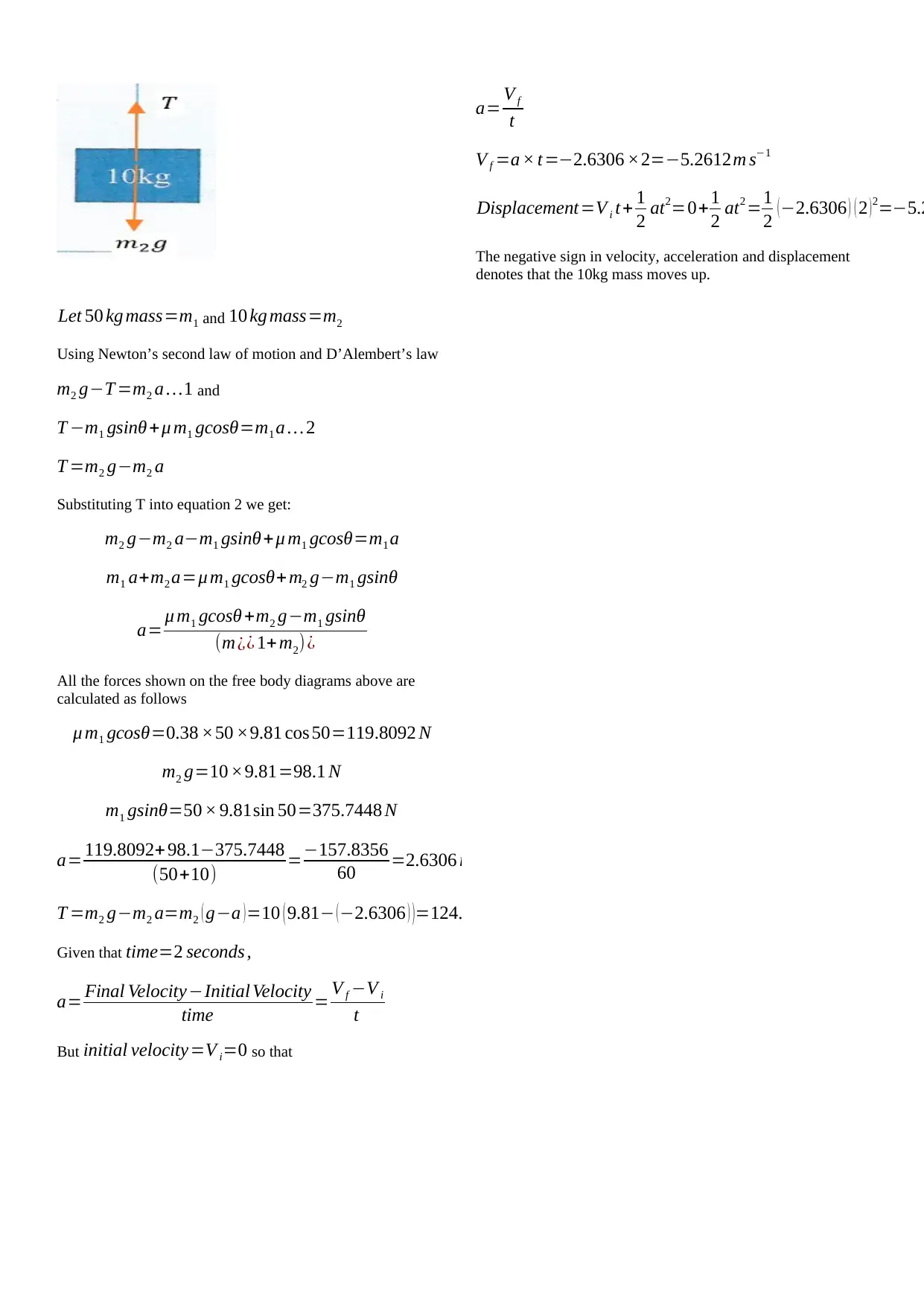Solved Problems in Mechanics and Thermodynamics
VerifiedAdded on 2023/06/12
|3
|915
|363
AI Summary
This document contains solved problems in mechanics and thermodynamics, including calculations related to beams, rafts, heat energy, and stress. The solutions are presented in a step-by-step format and cover topics such as moments, displacement, and Newton's laws of motion. The subject and course code are not mentioned.
Contribute Materials
Your contribution can guide someone’s learning journey. Share your
documents today.

ASSIGNMENT
Author
Department
Institution
City, Country
Address
Task 1
beam span=30 m
beam weight=10 kN /m=q1
uniformly distributed load =120 kN =q2 ( 8 m¿12 m)
Concentrated load=68 kN =p1 (at 12 m)
The sketch of the simply supported beam with the loads is
shown below:
We know that, the summation of moments about point A is 0.
That is, ∑ M A =0
∑ M A =−¿ q1 ( 30 ) ( 30
2 )−q2 ( 4 ) (8+ 4
2 )− p1 (12 )+RB ( 30 )=0 ¿
30 RB =450 q1+ 40 q2+12 p1
30 RB =450 (10)+40(120)+12(68)
RB= 4500+ 4800+816
30 = 10116
30 =337.2 kN
Also, the summation of moments about point B is 0. That is,
∑ M B=0
∑ M B=−RA (30 )+ ¿ q1 ( 30 ) (30−30
2 )−q2 ( 4 ) (22− 4
2 )+ p1 ( 18 )
30 RA =450 q1+ 80 q2 +18 p1
30 RA =450( 10)+80 (120)+18 (68)
RA = 4500+9600+1224
30 = 15324
30 =510.8 kN
Task 2
Total weight of cars 4 ×1600=6400 kg
weight of raft ¿ 4000 kg
mass of 1 barrel=15 kg
Density of foam=40 kg/m3
volume of 1barrel =π r2 h=π × 0.32 × 0.975=0.08775 π m3
mass of foam∈1 barrel=density × volume=40 × 0.08775 π =
Total mass of barrels=(3.51 π +15)kg × 70=1821.8893 kg
Total mass of raft =mass of raft +mass of barrels
¿ 1821.8893+4000=5821.8893 kg
Scenario 1: Empty raft
“According to the law of floatation, a floating object displaces
its own weight/mass.” Which implies that, the Mass of water
displaced equals 5821.8893 kg.
Volume of displaced water = mass
density =5821.8893
1029 =5.6578 m
S . A of raft base =7 ×6=42 m2
Author
Department
Institution
City, Country
Address
Task 1
beam span=30 m
beam weight=10 kN /m=q1
uniformly distributed load =120 kN =q2 ( 8 m¿12 m)
Concentrated load=68 kN =p1 (at 12 m)
The sketch of the simply supported beam with the loads is
shown below:
We know that, the summation of moments about point A is 0.
That is, ∑ M A =0
∑ M A =−¿ q1 ( 30 ) ( 30
2 )−q2 ( 4 ) (8+ 4
2 )− p1 (12 )+RB ( 30 )=0 ¿
30 RB =450 q1+ 40 q2+12 p1
30 RB =450 (10)+40(120)+12(68)
RB= 4500+ 4800+816
30 = 10116
30 =337.2 kN
Also, the summation of moments about point B is 0. That is,
∑ M B=0
∑ M B=−RA (30 )+ ¿ q1 ( 30 ) (30−30
2 )−q2 ( 4 ) (22− 4
2 )+ p1 ( 18 )
30 RA =450 q1+ 80 q2 +18 p1
30 RA =450( 10)+80 (120)+18 (68)
RA = 4500+9600+1224
30 = 15324
30 =510.8 kN
Task 2
Total weight of cars 4 ×1600=6400 kg
weight of raft ¿ 4000 kg
mass of 1 barrel=15 kg
Density of foam=40 kg/m3
volume of 1barrel =π r2 h=π × 0.32 × 0.975=0.08775 π m3
mass of foam∈1 barrel=density × volume=40 × 0.08775 π =
Total mass of barrels=(3.51 π +15)kg × 70=1821.8893 kg
Total mass of raft =mass of raft +mass of barrels
¿ 1821.8893+4000=5821.8893 kg
Scenario 1: Empty raft
“According to the law of floatation, a floating object displaces
its own weight/mass.” Which implies that, the Mass of water
displaced equals 5821.8893 kg.
Volume of displaced water = mass
density =5821.8893
1029 =5.6578 m
S . A of raft base =7 ×6=42 m2
Secure Best Marks with AI Grader
Need help grading? Try our AI Grader for instant feedback on your assignments.

Height of water displaced=height of barrel displaced
¿ volume
S . A of raft base =5.6578
42 =0.1347 m
% displacement of barrels= 0.1347
0.975 × 100 %=13.82%
Scenario 2: Raft with the four cars on board
Mass of water displaced equals
( 5821.8893+6400 ) kg=12221.8893 kg
Volume of displaced water = mass
density =12221.8893
1029 =11.87744 m3
S . A of raft base =7 ×6=42 m2
Height of water displaced=height of barrel displaced
¿ volume
S . A of raft base =11.87744
42 =0.2828 m
% displacement of barrels= 0.2828
0.975 ×100 %=29 %
Task 3
We calculate the heat energy required to raise ice at −20 ℃
to steam at 130 ℃ in bits as follows.
First, energy required to raise 15kg of ice to 0 ℃
Specific heat of ice= 0.50 cal
g ℃
Heat required = 0.50 cal
g ℃ × ( 15 ×1000 ) g ×20 ℃=150000 cal=150 kcal
Second, energy required to melt 15kg of ice at 0 ℃
Latent heat of melting ice= 80 cal
g
Heat required= 80 cal
g × ( 15 ×1000 ) g=1200000 cal=1200 kcal
Third, energy required to raise 15kg of ice to 100 ℃
Specific heat of water =1 cal
g℃
Heat required=1 cal
g ℃ × ( 15 ×1000 ) g× 100 ℃=1500000 cal=
Then, energy required to vaporize 15kg of water at 100 ℃
Latent heat of boiling water= 540 cal
g
Heat required=540 cal
g × ( 15 ×1000 ) g=8100000 cal=8100
Finally, energy required to raise 15kg of steam to 130 ℃
Specific heat of steam= 0.48 al
g℃
Heat required= 0.48 cal
g ℃ × ( 15 ×1000 ) g ×30 ℃=216000 cal
Total heat required= ( 150+1200+1500+8100+216 ) kcal=11
We know that change in temperature results in a change in
volume of the material. As a result, a body exposed to
temperature variations develops stress. That is, expansion or
contraction stress.
Task 4
The free-body diagrams are shown below
¿ volume
S . A of raft base =5.6578
42 =0.1347 m
% displacement of barrels= 0.1347
0.975 × 100 %=13.82%
Scenario 2: Raft with the four cars on board
Mass of water displaced equals
( 5821.8893+6400 ) kg=12221.8893 kg
Volume of displaced water = mass
density =12221.8893
1029 =11.87744 m3
S . A of raft base =7 ×6=42 m2
Height of water displaced=height of barrel displaced
¿ volume
S . A of raft base =11.87744
42 =0.2828 m
% displacement of barrels= 0.2828
0.975 ×100 %=29 %
Task 3
We calculate the heat energy required to raise ice at −20 ℃
to steam at 130 ℃ in bits as follows.
First, energy required to raise 15kg of ice to 0 ℃
Specific heat of ice= 0.50 cal
g ℃
Heat required = 0.50 cal
g ℃ × ( 15 ×1000 ) g ×20 ℃=150000 cal=150 kcal
Second, energy required to melt 15kg of ice at 0 ℃
Latent heat of melting ice= 80 cal
g
Heat required= 80 cal
g × ( 15 ×1000 ) g=1200000 cal=1200 kcal
Third, energy required to raise 15kg of ice to 100 ℃
Specific heat of water =1 cal
g℃
Heat required=1 cal
g ℃ × ( 15 ×1000 ) g× 100 ℃=1500000 cal=
Then, energy required to vaporize 15kg of water at 100 ℃
Latent heat of boiling water= 540 cal
g
Heat required=540 cal
g × ( 15 ×1000 ) g=8100000 cal=8100
Finally, energy required to raise 15kg of steam to 130 ℃
Specific heat of steam= 0.48 al
g℃
Heat required= 0.48 cal
g ℃ × ( 15 ×1000 ) g ×30 ℃=216000 cal
Total heat required= ( 150+1200+1500+8100+216 ) kcal=11
We know that change in temperature results in a change in
volume of the material. As a result, a body exposed to
temperature variations develops stress. That is, expansion or
contraction stress.
Task 4
The free-body diagrams are shown below

Let 50 kg mass=m1 and 10 kg mass=m2
Using Newton’s second law of motion and D’Alembert’s law
m2 g−T =m2 a …1 and
T −m1 gsinθ +μ m1 gcosθ=m1 a … 2
T =m2 g−m2 a
Substituting T into equation 2 we get:
m2 g−m2 a−m1 gsinθ+μ m1 gcosθ=m1 a
m1 a+m2 a=μ m1 gcosθ+ m2 g−m1 gsinθ
a= μ m1 gcosθ +m2 g−m1 gsinθ
(m¿¿ 1+m2)¿
All the forces shown on the free body diagrams above are
calculated as follows
μ m1 gcosθ=0.38 ×50 ×9.81 cos 50=119.8092 N
m2 g=10 ×9.81=98.1 N
m1 gsinθ=50 × 9.81sin 50=375.7448 N
a= 119.8092+ 98.1−375.7448
(50+10) =−157.8356
60 =2.6306 m s−2
T =m2 g−m2 a=m2 ( g−a )=10 ( 9.81− (−2.6306 ) )=124.406 N
Given that time=2 seconds ,
a= Final Velocity−Initial Velocity
time = V f −V i
t
But initial velocity=V i=0 so that
a= V f
t
V f =a × t=−2.6306 ×2=−5.2612m s−1
Displacement=V i t+ 1
2 at2=0+1
2 at2 =1
2 (−2.6306 ) ( 2 )2=−5.2
The negative sign in velocity, acceleration and displacement
denotes that the 10kg mass moves up.
Using Newton’s second law of motion and D’Alembert’s law
m2 g−T =m2 a …1 and
T −m1 gsinθ +μ m1 gcosθ=m1 a … 2
T =m2 g−m2 a
Substituting T into equation 2 we get:
m2 g−m2 a−m1 gsinθ+μ m1 gcosθ=m1 a
m1 a+m2 a=μ m1 gcosθ+ m2 g−m1 gsinθ
a= μ m1 gcosθ +m2 g−m1 gsinθ
(m¿¿ 1+m2)¿
All the forces shown on the free body diagrams above are
calculated as follows
μ m1 gcosθ=0.38 ×50 ×9.81 cos 50=119.8092 N
m2 g=10 ×9.81=98.1 N
m1 gsinθ=50 × 9.81sin 50=375.7448 N
a= 119.8092+ 98.1−375.7448
(50+10) =−157.8356
60 =2.6306 m s−2
T =m2 g−m2 a=m2 ( g−a )=10 ( 9.81− (−2.6306 ) )=124.406 N
Given that time=2 seconds ,
a= Final Velocity−Initial Velocity
time = V f −V i
t
But initial velocity=V i=0 so that
a= V f
t
V f =a × t=−2.6306 ×2=−5.2612m s−1
Displacement=V i t+ 1
2 at2=0+1
2 at2 =1
2 (−2.6306 ) ( 2 )2=−5.2
The negative sign in velocity, acceleration and displacement
denotes that the 10kg mass moves up.
1 out of 3
Your All-in-One AI-Powered Toolkit for Academic Success.
+13062052269
info@desklib.com
Available 24*7 on WhatsApp / Email
![[object Object]](/_next/static/media/star-bottom.7253800d.svg)
Unlock your academic potential
© 2024 | Zucol Services PVT LTD | All rights reserved.

